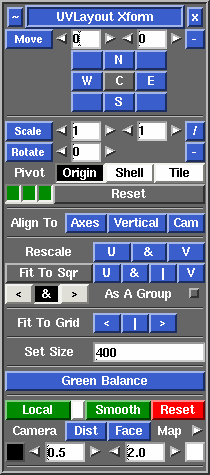User Guide: Move/Scale/Rotate
From UVLayout Docs
|
Open up the Move / Scale / Rotate panel if you want to apply a global numeric translate, scale or rotate to one or more shells.
Set the values you want to apply, then click on Move, Scale or Rotate to transform all picked shells. If no shells are picked, all unlocked flattened shells are modified. If Local is ticked, the scales and rotates will pivot around the center of each individual shell, otherwise the origin (i.e. u=0, v=0) is used. Use the Invert button to invert all values so you can quickly transform shells back to where they were, and the Reset button resets the field values back to their defaults. The three green buttons to the bottom left represent the left, middle and right mouse buttons. By default these are all on, indicating that you can rotate (left), translate (middle) and scale (right) shells by holding down the Space key. Click on any one of the green buttons to turn that function off. For example, if you don't want to accidentally scale any shells, click the third button so it turns gray.
Normally UV shells in UVLayout are resized so that the texture scale is even across the entire surface; this is what the Rescale buttons above do. This means that when the checker texture is applied, all squares appear as close to the same size as possible. Sometimes however you may want to assign increased or reduced scales to specific parts. Some examples would be increased scale for greater detail in a creature's face and hands, but reduced scale for the inside of the mouth where very little detail is required. In UVLayout this is called a mixed scale layout, and the following buttons are used to create them. These replace the Green Balance tool which briefly appeared in UVLayout v1.19.3.
|
